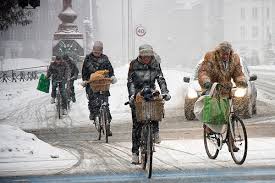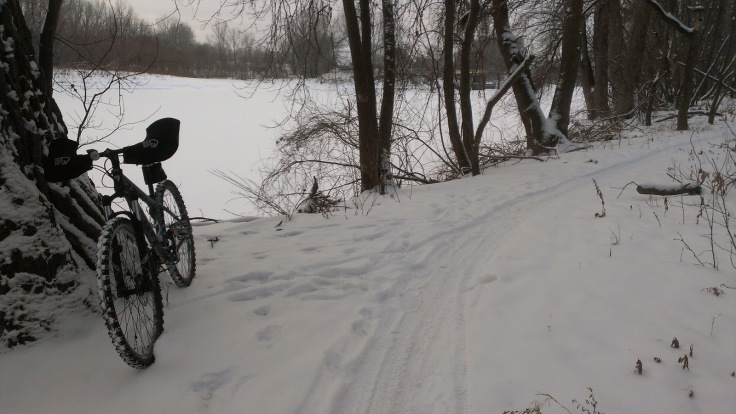
It’s amazing how easy it is to simply grab your bike and head out the door during the summer months. Socks and shoes, shorts and a jersey, pop on your helmet and you’re good to go. Once winter shows up it’s a whole different scenario. It takes more time to prepare for a ride that will be comfortable to stay out on, rather than turn around and head home to the surrender of the television set.
You can cheat the weather all you want to in the summer. Wear whatever you wish and within reason, it won’t be all that detrimental. Try that in the winter time and things can get pretty miserable. You can end up in a lot of trouble.
Fortunately, cold weather riding can be just as rewarding as it is in the warm months. There are all sorts of cold weather cycling gear available that really change your outlook towards the “off season”. It’s too bad that Frodo and company didn’t have access to microfleece tights while on their way to Mordor. It would have made their journey a heck of a lot more enjoyable.
Building a winter kit doesn’t have to break the bank. You can pick up a piece or two each year. Even with one or two items you’ll notice a difference when you ride.
A good place to start would be with the buying of a pair of tights. You can buy regular tights which are really nothing more than your normal lycra riding shorts with legs. These are okay for slightly cool rides, but their window of usage is fairly short. The ones to buy are what are known as microfleeced tights. These are lycra tights that have a lining made out of very fine soft polarfleece. They are very warm, have a wide range of temperature usage from cool autumn or spring rides to downright cold winter days, and they wick sweat away from the skin remarkably well. You can also buy them with a water and windproof storm panel on the front of the thighs for extra protection. Tights are one of those items that’ll make you wonder how you ever got along without them.

Long sleeved winter jerseys are similar to the tights. They are also microfleeced for extra warmth and wicking ability. Winter riding jackets are designed to cut the wind. Most of them go beyond being water resistant and are waterproof. They have taped seams to ensure that no moisture gets in. These jackets have extra long tails on them to keep your rear end from getting wet. The sleeves are cut longer as well. You’ll find extra reflective details for higher visibility in traffic.
For the feet you can do a few things. Regular boots can be used with platform pedals. If you use clipless pedals there are winter cycling shoes that have extra cold and wet protection. For normal cycling shoes, you can use neoprene booties or shoe covers to help keep your feet warm and dry. If you want the minimum, there are toe covers that go over the fronts of your shoes.
Hands are simple. There is a wide variety of winter cycling gloves available. Most gloves can be worn in temperatures that are colder than what the tag recommends. A relatively new item that is gaining in popularity, especially with the fatbike crowd, is the Bar Mitt. These are neoprene hand sleeves that attach to the handlebars of your bike, over your grips and levers. These allow for extra warmth and prevent wind from getting inside your sleeves. They let you wear a lighter glove for less clumsy shifting. Bar Mitts are great for hybrid riders who ride open railtrail too.
When it comes to keeping your head warm, there are three key items that work amazingly well. Many riders and runners use microfleece lined beanies or full balaclavas. These keep your head warm like a toque, but still allow a helmet to fit over them. One of the best items out there is a helmet cover. These are made of lycra with a rubberized lining. They stretch over your helmet and effectively block the wind and moisture from coming through the holes. They can be used by themselves but for the best experience, pair one with a beanie or balaclava.
Winter riding is a great cure for cabin fever. Cold weather riding gear lets you extend your riding season for as long as you want to. Like someone once said, “there is no wrong weather, just wrong clothing.”






 We don’t just have road bikes. We have different kinds of road bikes. Ones for racing, ones for recreational sport riding, ones for the dirt tracks of cyclocross, ones for the rebirth of cycle touring (hallelujah!) and some for something called “gravel grinding”.
We don’t just have road bikes. We have different kinds of road bikes. Ones for racing, ones for recreational sport riding, ones for the dirt tracks of cyclocross, ones for the rebirth of cycle touring (hallelujah!) and some for something called “gravel grinding”. Fatbikes use 26″ wheels with 4″ or 5″ wide tires and big sidewalls. The overall diameter of this is roughly equal to a 29″ wheel. The new 27.5+ size uses a 27.5″ wheel with a 3″ wide tire and big sidewall. This also roughly equals 29″. This size will be a great “lite” alternative to a full blown fatbike for many people. The cool thing about fatbikes is that you can run any sized wheel in them. I’ve seen pictures of a fatbike with a set of redished cyclocross wheels in it. Any crazy thing you want.
Fatbikes use 26″ wheels with 4″ or 5″ wide tires and big sidewalls. The overall diameter of this is roughly equal to a 29″ wheel. The new 27.5+ size uses a 27.5″ wheel with a 3″ wide tire and big sidewall. This also roughly equals 29″. This size will be a great “lite” alternative to a full blown fatbike for many people. The cool thing about fatbikes is that you can run any sized wheel in them. I’ve seen pictures of a fatbike with a set of redished cyclocross wheels in it. Any crazy thing you want.
Recent Comments